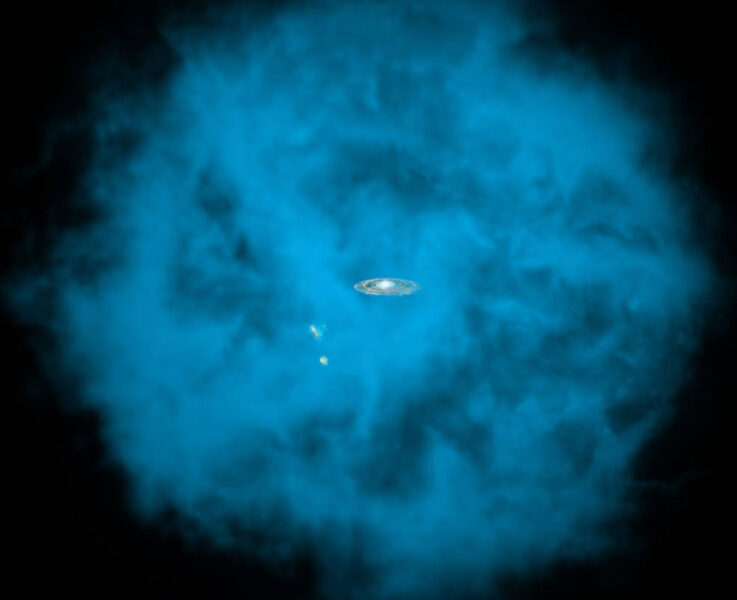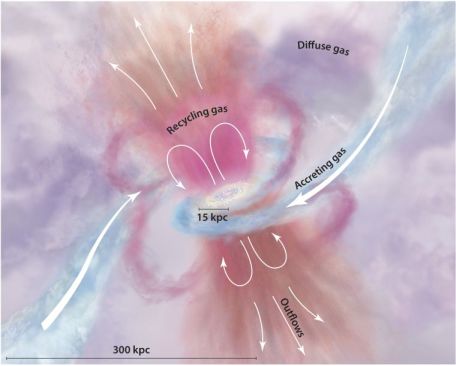New observations show ultra-hot gas around the Milky Way. Stellar explosions may have driven this gas out of our galaxy.
Our galaxy must be gorgeous from the outside: a vast barred spiral disk of dust, gas, and stars. But there’s a part of it that’s nearly invisible, and thus often overlooked. Astronomers have long known that a halo of sparse hot gas surrounds the Milky Way, most of it left over from our galaxy’s formation. But it evades all but a few forms of detection.
Now, astronomers think they’ve found even hotter gas out there, a discovery that will ultimately shed light on our galaxy’s evolution.
The Original Halo
Galaxies were not the first things to come together in the early universe — first came huge clumps of dark matter. This invisible, transparent stuff pervades galaxies and galaxy clusters today, and simulations show it predates them, too. Dark matter amassed around slightly denser regions of the primordial soup of the early universe, and the gas followed.

NASA / CXC / M.Weiss / Ohio State / A. Gupta et al.
As the gas fell in, it heated up to temperatures between 10,000 and 1 million kelvin (20,000–1.8 million°F). Some of this hot gas cooled and settled into a central galaxy, but a lot of it stayed hot and spread out across a vast halo. Because it’s so hot, it’s highly ionized, meaning atoms have lost not just one but many of their electrons. It’s also sparse. Combined, these characteristics make it difficult — but not impossible — to detect. Nevertheless, it’s well worth studying — its shape ought to echo the shape of the dark matter halo that we can’t see at all.
Astronomers have largely been detecting halo gas indirectly using distant quasars. To some astronomers, these brilliant, gas-guzzling black holes are more interesting for what’s in front of them, as any gas lying along the same line of sight will absorb their light.
The Hotter Halo
Now, a study using the quasar method has found evidence of even hotter gas, its temperature approaching 10 million K. Smita Mathur (Ohio State University) and Anjali Gupta (Columbus State Community College) presented the results at the recent virtual meeting of the American Astronomical Society.
The team used the European Space Agency’s XMM-Newton telescope to take an X-ray spectrum of a quasar, finding that ionized oxygen and neon nearby — that is, in the Milky Way’s halo — had absorbed some of its light. The high levels of ionization indicate gas at a temperature near 10 million K. That’s much hotter than typical halo gas, and it’s too hot to explain as gas that’s falling into the halo. Instead, supernova explosions or stellar winds could be flinging it out of the galaxy.

Tumlinson et al., Annual Reviews of Astronomy & Astrophysics 2018
The 10 million-degree gas has more heavy elements than the Sun does, supporting the supernova scenario. It could be part of a cycle of gas that drives star formation (or quenches it) in the Milky Way. “We’re just at the discovery stage here,” Mathur says.
The thing is, looking along one line of sight toward one bright background source could give misleading results. So Mathur and Gupta set out to see if they’d find the same thing along other sightlines to other distant quasars. They obtained X-ray observations of four additional quasars and confirmed their initial result: three of the four quasar spectra showed absorption from 9 million K gas with an abundance of heavy elements. (This research is still a work in progress, though, and will be submitted to academic journals later this month.)

All-sky X-ray survey: MPE and S. L. Snowden
The uber-hot gas is a new discovery, Mathur says, so far seen only in the Milky Way and in the galaxy NGC 3221, which we reported June 2nd.
A Difficult Measurement
Caveats remain, though. Mathur and Gupta acknowledge that other explanations could explain the X-ray data they’ve collected, though they say the ultra-hot gas scenario fits the data the best. But the concerns are inherent in the way data on the halo is currently collected, says Dan McCammon (University of Wisconsin, Madison).
“The current problem with observations of diffuse hot gas is that we don't have very good instruments,” McCammon says. “So there isn't nearly as much data as we really need to untangle all the things that get added together along a line of sight.”
That said, he adds that there’s a lot of evidence that the gaseous halo around the Milky Way has different parts to it, each with different temperatures. “Theorists would have us expect something like that,” he explains. After all, if gas released from supernova explosions is to escape into the halo, it must reach temperatures of at least 5 million K. “So maybe we shouldn't be surprised to also find temperatures like this in the circumgalactic medium.”
Even though McCammon sees “potential problems” in the research due to the limitations of current instruments, he adds, “I do think they're quite possibly right.” Ongoing and upcoming missions, such as Erosita, may put such results on firmer footing as they observe the X-ray-emitting sky in better detail than ever before. “There’s hope for the future.”
 2
2









Comments
Anthony Barreiro
June 16, 2020 at 7:51 pm
The watercolor diagram of a galactic gaseous halo is quite beautiful and rather hypnotic.
300,000 parsecs is almost a billion light years. 15,000 parsecs is about 50,000 light years, or roughly the radius of our milky way galaxy. So all the stars of our entire galaxy are just the little swirl right in the middle. Puts things in perspective ... .
You must be logged in to post a comment.
Roger Venable
June 18, 2020 at 6:25 am
How does a sparse plasma / gas stay so very hot for hundreds of millions of years? Its inherent radiation of X-rays should cool it rapidly. I think that, by radiation, it should cool to the temperature of the cosmic background in a matter of minutes unless there is a continuing input of energy from somewhere. Where's the energy coming from right now? It seems to me that this is a big mystery.
You must be logged in to post a comment.
You must be logged in to post a comment.